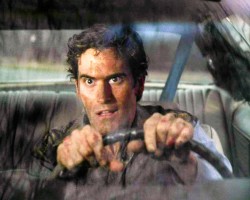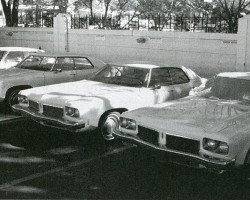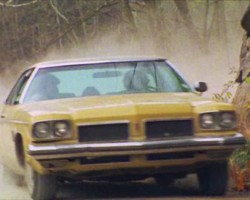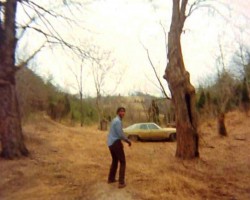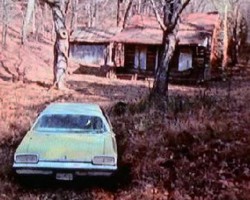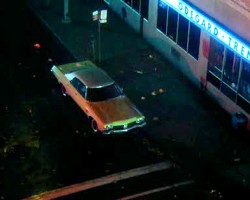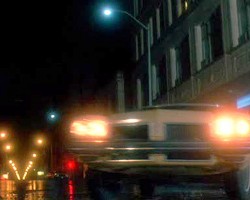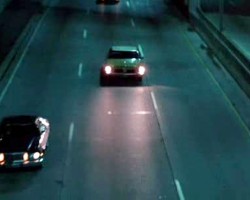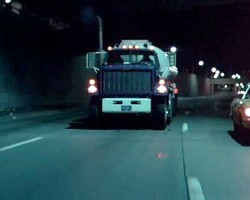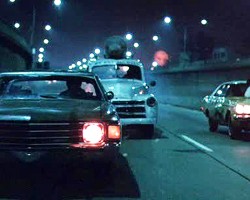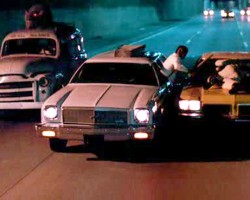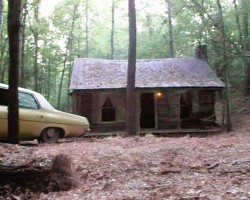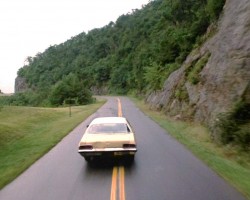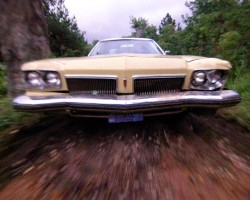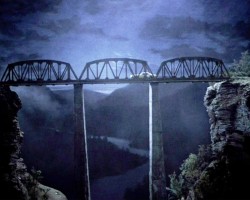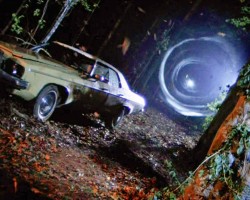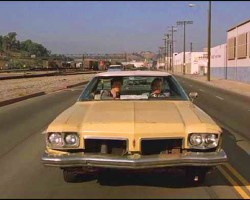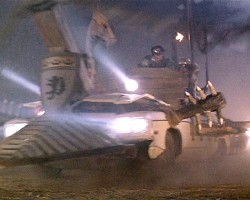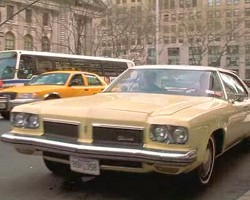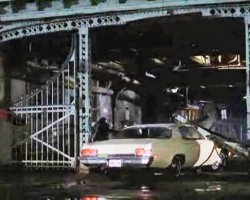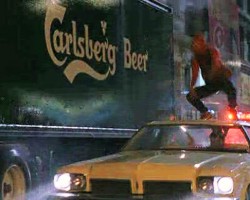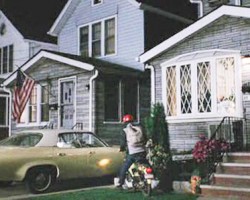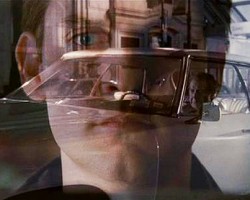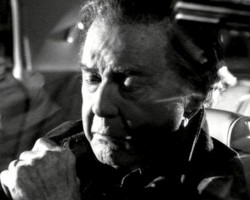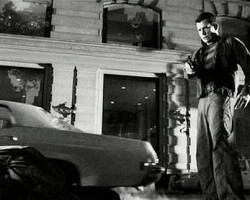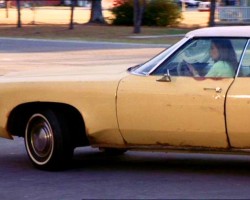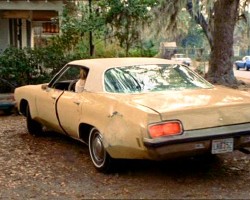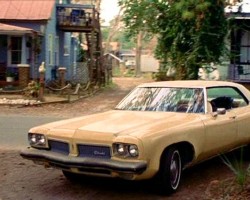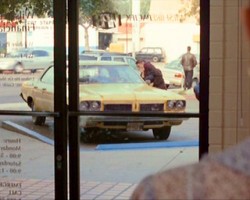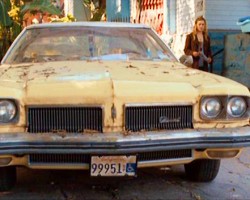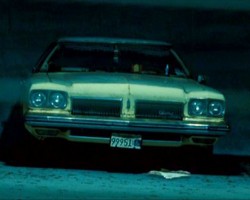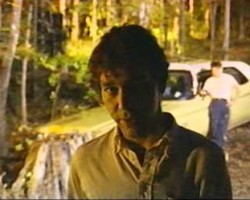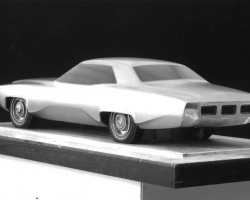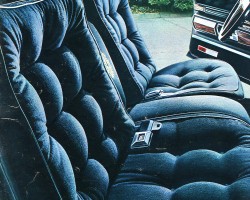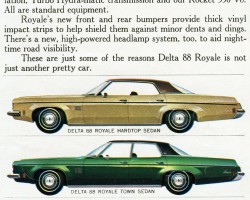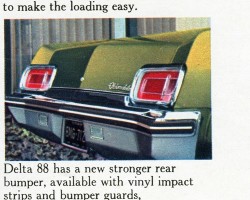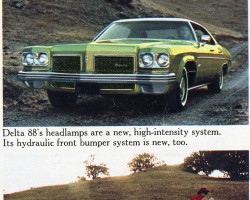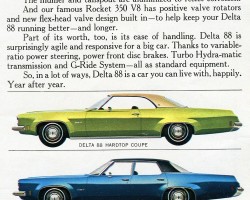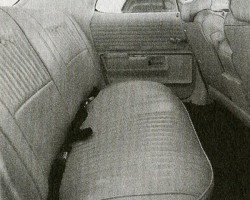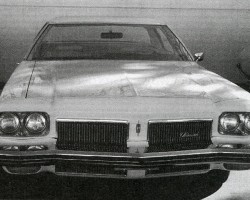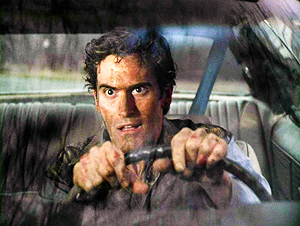
Actor Bruce Campbell pilots director Sam Raimi’s Oldsmobile Delta 88 in “Evil Dead 2”. Campbell and Raimi were childhood friends from Michigan who got into making movies together. From the earliest 8mm movies they made as teenagers, Raimi has always integrated the ’73 Oldsmobile his parents bought new somewhere in the background of each film he’s done since. Says Campbell, “This car’s been in more damn movies than I have.”
When I was growing up, my father owned a full-size ’73 Oldsmobile from 1975 until 1983. During that era in the United States an Olds was a respected car that middle class people of all age groups aspired to, upper-middle-class people held their heads up high in, and very wealthy people bought when they decided a Cadillac, Mercedes or Rolls was too ostentatious. And like any product seen as cool or smart, you bought an Oldsmobile because you truly wanted one, not because you were forced to compromise.
I always liked the Chestnut Brown ’73 Olds we had and looked forward to the times when my father would let me sit behind the wheel and perform a checklist to make sure every power switch and control worked. Riding in it was always enjoyable because no matter what kind of mood you were in when you stepped into the car, life’s troubles just seemed to slip away after a few minutes of sitting on the decadently soft and comfy pillowed velour seats. Because they simply gave one a feeling of warmth and security.
(Photo slideshow of larger pictures of Sam Raimi’s Delta 88 in movie scenese is at the end of this article)
Before I ever had the chance to drive the ’73 Olds, it left our family sadly in 1983 when its 455 engine developed internal bearing problems that would be more costly to fix than my father felt the car was worth. He replaced it with a two-year-old 1981 Olds 98 Regency which was a modernized, square-edged, and downsized version of the 1971-76 body style.
Long after the ’73 was gone, I continued to take notice any time I’d see other ones appear on the road, on the television screen, or in various movies. One such time was in the late 1980s watching a double-feature of Sam Raimi’s directorial debut movie The Evil Dead (1981) and later remake of it known as The Evil Dead 2 (1987). Both versions have become cult classics for their self-effacing humor and spoofing of bad horror films. In versions I and II, the plot centers on a main character (played by Raimi’s childhood friend Bruce Campbell) who drives to a remote wooded cabin for a relaxing weekend only to accidentally release demons that he, his girlfriend, and others must combat.
Numerous scenes feature a beat-up ’73 Oldsmobile Delta 88 driven by Campbell during his trip to the woods, attempted escape, and ending scenes – one of which features he and the car being sucked into a time portal in order to later reappear in The Evil Dead Part III (1991). Shortly thereafter in 1990 when another Sam Raimi-directed film Darkman made its cinematic debut, I was in a theater watching when I noticed a similar Delta 88 being driven by henchman of the main character Durant played by Larry Drake.
It would be years later before I came to realize that Raimi always featured the same car, his car (originally purchased new by his father then handed down to him) somewhere in every movie he had ever directed. Raimi’s creativity and strong visual style through inventive and startling camera work over the years caught the attention of numerous critics and brought him a long way, from directing The Evil Dead in 1981 with a budget of $350,000 to Spider Man 3 in 2007 with production costs of $350 million.
I truly appreciate Raimi’s sense of humor and self-mocking about how he pledges to figure out some way to get it in a scene somewhere on future endeavors. It’s reported he even had a corner of the Delta 88 just barely visible underneath a specially-built covered wagon in one short scene in his 1995 western film The Quick and the Dead set in the 1800s.
Raimi’s close friend and accomplished actor Bruce Campbell reflected on the long history both of them had with the Delta 88 in his 2001 autobiography If Chins Could Kill – Confessions of a B-Movie Actor. Campbell recalled growing up in Michigan together when they would borrow the car from Raimi’s father as teens and use it as a prop in movies they would make with a hand-held Super 8 film camera. “This damn car has been in more movies than I have!” begins Campbell on the subject. “For some reason, it became the all-purpose car that appeared in almost every Super-8 film we ever made. When Sam began to make feature films, he kept using it – starting with Evil Dead in 1979. Sam dubbed it ‘The Classic’.”
Bruce Campbell quoted another friend of Sam’s – adding, “I think he got laid for the first time in the Classic, that’s why it’s so important to him.” Bruce also spoke of his own car during the early ’80s when the struggling group of actors could barely pay their rent. “My crappy car, an Opel Isuzu, had also been in several of our shorts, but Sam would only refer to it offhandedly as a ‘pseudo foreign sub-classic’. The best any other car could hope for was ‘sub-classic'”.
During the 1985 filming of CrimeWave, Raimi had purchased several other ’73 Delta 88s in the same color that would effectively step in as stunt doubles for the original when car chase scenes were created. Campbell was there and remembers when their mechanic approached him to ask which one of the Deltas he should modify and mount on a sliding rail car so that scenes could be shot from inside the vehicle. Since the mounting platform could not support the weight of an entire car, anything installed on it would need to have as much weight removed as possible.
Sam’s own personal car was the only one with the right color interior to maintain continuity with previous scenes involving the car, so Campbell told the mechanic to go ahead and make modifications to The Classic instead of either of the other two stunt doubles. The next morning, when Sam realized the Delta 88 he saw on the rail car with engine, transmission, and wheels removed was his own, he turned to Campbell and said “You gutted my car! You tried to kill the Classic! Hard as you try, you will never kill the Classic.”
Campbell remembers in 1987 when he and Sam Raimi remade The Evil Dead with better effects and new twists (dubbing it The Evil Dead II ), Sam had the ’73 Olds brought down from his home state of Michigan to North Carolina on the back of a flatbed truck because it was not running at that point.
“By this time, Dave Goodman was the transportation coordinator and the car became the bane of his existence. It was just a pain in the ass. Sam needed specific things in the car to work because he had certain shots within the car that he needed and he would never bend. I said ‘Sam, you can’t do it this way – it’s going to cost you this much money,’ and he says ‘I don’t care. I want it the way I want it.’ It was almost like he was crazy about it.”
In a 2001 conversation between Raimi and himself also transcripted in If Chins Could Kill, Campbell asked his old friend to estimate if the still-original percentage of the Delta 88 was greater than five percent, Raimi replied, “The basic body and frame is still original. Well, okay the motor is not original. Most of the working engine parts are probably not original. Some of the upholstery is not original, but it’s got the original dash and steering wheel. The body has a lot of bondo, I admit”.
Campbell asked where the Delta 88 was at the time which brought a laugh and vague answer from Raimi. “In a warehouse in Southern California” was all he would say. Campbell then commented “He knew if I ever found out, an army of mechanics would be dispatched to destroy it”.
I truly understand how you feel about your 1973 Oldsmobile, Sam. May you always keep your sense of humor and be able to value the things in life which stem from your roots that truly make you who you are.
-Sean
For a fully detailed list of Sam Raimi films, see Internet Movie Database link http://www.imdb.com/name/nm0000600/#Director
CLICK ON ANY OF THE PHOTOS BELOW TO SEE LARGER IMAGES. HIT ARROW BUTTONS UNDER EACH PICTURE TO SCROLL BACKWARDS OR FORWARDS.
- According to actor Bruce Campbell, Raimi’s childhood friend, “This damn car has been in more movies than I have”.
- While Sam’s 1973 Oldsmobile (center) was often beat up and damaged in early films, today the Delta 88 has stunt doubles for the hard knocks.
- In Sam’s first movie “Evil Dead” (filmed during 1979-80 in Tennessee), four youths travel in the Delta 88 to a cabin in the woods for a weekend of horror.
- Film and TV star Bruce Campbell attempts to reach the safety of the Olds Delta 88 at the end of “Evil Dead”.
- This photo was taken during the filming of Sam Raimi’s first movie “The Evil Dead”.
- Sam’s car appearing in another of his early movies, “CrimeWave” (1985).
- During “Crimewave” (1985), the 1973 Olds gets itself immersed in a hostile takeover.
- The plot of Crimewave focuses on a nerd who is framed for murder.
- The “nerd” then narrates, telling the story of how he was set up by two cartoon-like hitmen.
- By 1985 Sam’s car had lost all its original hubcaps, as seen during this action scene in “Crimewave”.
- Several 1973 Olds look-alikes were purchased as doubles for the action scenes in “Crimewave”.
- In 1987, Sam Raimi, Bruce Campbell, and the Delta 88 teamed up to remake the original “Evil Dead” story, dubbing it “Evil Dead II”.
- This scene from Evil Dead 2 was filmed by Sam Raimi and friends actually laying on top of the roof of a van that was following the Delta 88.
- Here, Bruce Campbell races backwards in the Delta 88 attempting to flee approaching evil in Evil Dead 2.
- A spooky, albeit fake-looking, scene where the Olds crosses a bridge on the path to evil.
- At the end of “Evil Dead 2”, Raimi’s 1973 Oldsmobile gets sucked into a time vortex – where it makes an appearance in Part 3 of the movie trilogy.
- In Darkman (1990), Sam’s Delta 88 is piloted by “bad guys” before being smashed into by protagonist Liam Neeson.
- In “Evil Dead 3” (1991), Bruce Campbell and the Olds slip into a time portal to the middle ages, where battle armor is applied to make the “Deathcoaster”.
- When Sam Raimi directed the first “Spider Man” movie in 2002, the Olds made appearances as the car belonging to Peter Parker’s grandfather.
- The carjackers try to hide from Spider Man, but it’s to little avail.
- During the first Spider Man movie, Peter’s grandfather is murdered when his Delta 88 is carjacked. Here, Spider Man goes for vengeance.
- Nicely restored at this point, the 1973 Olds Delta 88 makes an appearance in the background of Spider Man 2 outside Peter Parker’s house.
- In Spider Man 3 (2007), Peter’s grandfather had been long dead but Sam creatively worked in a flashback appearance for the Delta 88.
- The black and white made for a good flashback of Peter’s grandfather, and the Delta 88.
- In part 3 of Spider Man, the audience gets to see Sam’s car because of a flashback scene based on Peter’s grandfather being carjacked and shot in Part 1.
- Scene from “The Gift” featuring Raimi’s Olds.
- Sam Raimi’s 1973 Oldsmobile Delta 88 in “The Gift”.
- When Sam directed “The Gift” (2000), Cate Blanchett’s character gifted with ESP drives the Delta 88 throughout the movie.
- The main character from “Drag Me To Hell” (2009) is a loan officer who evicts an old woman from her home to find herself the recipient of a supernatural curse.
- In “Drag Me To Hell” (2009), the main character on the run from an evil curse approaches the ’73 Delta 88.
- Filming “Drag Me To Hell”, Raimi might have borrowed a page from the movie “Christine” where the central vehicle in the movie lurks in a parking garage.
- In this picture, Sam Raimi stands in the foreground of the ’73 Delta 88 during the filming of “Evil Dead 2”.
- For perspective, this was the first styling mockup for the 1971-76 generation Oldsmobile Delta 88.
- The tufted velour seating optional on 1973 Oldsmobile full-size models. No matter what mood you’re in entering the car, these seats always make you feel better.
- In this page from the 1973 Oldsmobile brochure, buyers can see the difference between a 4-door hardtop (no pillars) and pillared sedan models. Raimi’s is a hardtop.
- The “vacation-sized” trunk of a 1973 Oldsmobile Delta 88.
- The 1973 Olds brochure shows Delta 88s traveling remote roads similar to those found in Raimi’s “Evil Dead” movies.
- Hardtop coupe or pillared sedan? Buyers had a wealth of choices.
- Bruce Campbell quoted another friend of Sam’s – adding, “I think he got laid for the first time in the Classic, that’s why it’s so important to him.”
- Here, one of many stunt doubles for Raimi’s 1973 Oldsmobile Delta 88 sits on the studio lot.


